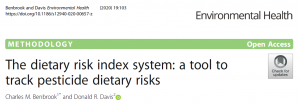By: Chuck Benbrook
A milestone in my career occurred on October 14, 2020 with the publication of “The dietary risk index system: a tool to track pesticide dietary risks” in the peer reviewed journal Environmental Health. This paper was written with my friend and co-author Dr. Donald Davis.
It is the culmination of work started in 1985, and represents tens of thousands of hours of work, and millions of dollars of investment over many years by private foundations.
The simplest way to describe what the Dietary Risk Index (DRI) system makes possible for those curious about pesticide dietary risk levels and trends is an analogy to one of the 17 wonders of the world — the iPhone.
In the world of pesticide dietary risks, the DRI is like going from a rotary phone to an iPhone 11 in one jump.
Access the paper and a summary of key findings here. We have lots of additional details on the DRI here on Hygeia, including a description of the methodology and data sources that drive the Dietary Risk Index system, the different forms of the DRI, various applications of the DRI, and where the “hot potato” samples lurk in the global food supply (“hot potato” samples = high-risk samples).

In 1984, while serving as the ED of the Board on Agriculture in the National Academy of Sciences (NAS), EPA asked the Board to conduct a study on the statutory genesis of the Delaney Paradox. This paradox arose from conflicting provisions in two federal statutes — the Food, Drug, and Cosmetic Act (FDCA) and the Federal Insecticide, Rodenticide, and Fungicide Act (FIFRA). The FDCA directed EPA to jump in one direction when regulating certain cancer-causing pesticides, and the FIFRA statute sometimes directed EPA to jump in the exact opposite direction.
This conflict in federal law led to a pernicious outcome. It turned the well-known, anti-cancer Delaney Clause in the FDCA into a regulatory enigma that prevented EPA from approving use of some new pesticides that would have clearly reduced cancer risks.
I helped put together the NAS Committee that carried out the EPA-funded Delaney Paradox project. The Committee worked with the Board staff and Dr. John Wargo, then a young scientist at Yale, to carry out the first-ever cumulative cancer risk assessment across all pesticides then registered for use on food crops.

A few years later, during a 10-year run of work with Consumers Union, I developed a method to quantify pesticide risk trends based on pesticide toxicity and the pounds of pesticides applied.
A second NAS project started in 1988 during my years as the Board on Agriculture ED. It came to fruition in 1993 with the release of the report Pesticides in the Diets of Infants and Children by the NAS, a seminal report widely praised by all stakeholders. Its core recommendations became the guts of the Food Quality Protection Act (FQPA). The FQPA was passed unanimously by both Houses of Congress and signed into law by President Clinton in 1996.
The Pesticides in the Diets of Infants and Children report drew on the first-ever cumulative risk assessment of residues of organophosphate (OP) insecticides in major children’s foods. The methodologies pioneered by this NAS Committee and presented in this report were another stepping stone along the way to today’s DRI.
One of the FQPA’s historically significant, new provisions called upon EPA to conduct cumulative pesticide risk assessments across all routes of exposure, and encompassing all pesticides that posed risks to people via a common mechanism of biological action — like the OPs.
In passing the FQPA, Congress directed EPA to routinely do what the 1986 Delaney Paradox and the 1993 Pesticides and Kids reports had done for the first time.
Beginning in late 1996 and lasting through 2001, I was honored to work with Consumers Union on the EPA’s implementation of the just-passed FQPA. The goal of the FQPA was to empower EPA to deal more effectively with the adverse impacts of pesticides ingested via food and beverages by pregnant women, infants, and children.
To accomplish that goal and advise Consumers Union on how to encourage EPA to move ahead with FQPA implementation, a system was needed that is capable of identifying: (a) the foods posing the most serious risks as a result of pesticide residues, and (b) the pesticides accounting for the most significant risks.
In short, we needed the DRI.
So, we compiled all publicly accessible pesticide residue data from the USDA’s “Pesticide Data Program” and the toxicology data and chronic exposure benchmarks on pesticides set by the EPA.
In recent years, we turned the DRI into a global system by also incorporating into the DRI the high-quality pesticide residue data from the UK-Food Standards Agency, and thank the Sheepdrove Trust in the UK for the funding needed to carry out that challenging task.
Ever wonder what food, grown where, contains the highest level of a pesticide ever reported by either the USDA or the UK-FSA? The answer is now accessible via the DRI — lettuce grown in the UK.

The backbone of the DRI system is a series of equations that calculate how serious the residues are in a given serving of food in a given year, based on the residues found by USDA and the amount of pesticide that a person can ingest in a day without triggering EPA’s “level of concern.”
In 1981, I was the ED of the Congressional Subcommittee on the House side with jurisdiction over the federal pesticide law, FIFRA. I was blessed by the chance to work with, and learn from the Subcommittee Chairman, the late Cong. George E. Brown, a leader in Congress on all matters steeped in science and technology.
After a particularly bothersome (to me) setback in the work of the Subcommittee, Congressman Brown took me aside and said all was not lost because we had gained deeper understanding of a complex challenge in the world of pesticide regulation. He said, “Dr. Benbrook, the first step in solving a problem is understanding where it comes from.” These sage words stuck with me and have served as a North Star guiding my work ever since.
Despite the powerful new tools given to EPA in the FQPA back in 1996, significant pesticide dietary risks persist in the US and global food supply. The only way farmers, the food industry, the EPA and other regulators can get rid of them is to know where they are.
The DRI system paper published today is an important milestone in my personal journey, but more importantly, it makes available to everyone a tool that shines a bright light on high-risk pesticide-food combinations. As others work with and further refine the DRI over the years, hopefully that bright light on high-risk food-pesticide combinations will finally assure the public health goals of the 1996 FQPA are fully realized.

